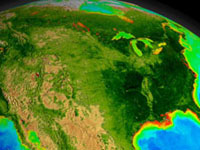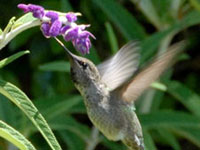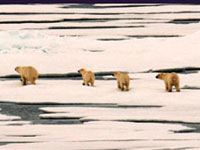 What do polar bears, hummingbirds, clams, bowhead whales and invasive plant species have to do with Earth science spacecraft orbiting overhead 24/7? Soon observations from NASA's Earth-observing satellites of our planet's climate will be brought to bear on understanding how different species and ecosystems respond to climate changes and developing tools to better manage wildlife and natural resources.
What do polar bears, hummingbirds, clams, bowhead whales and invasive plant species have to do with Earth science spacecraft orbiting overhead 24/7? Soon observations from NASA's Earth-observing satellites of our planet's climate will be brought to bear on understanding how different species and ecosystems respond to climate changes and developing tools to better manage wildlife and natural resources.
What do polar bears, hummingbirds, clams, bowhead whales and invasive plant species have to do with Earth science spacecraft orbiting overhead 24/7? Soon observations from NASA's Earth-observing satellites of our planet's climate will be brought to bear on understanding how different species and ecosystems respond to climate changes and developing tools to better manage wildlife and natural resources.

Satellite observations of vegetation on land and microscopic marine plants that form the base of ocean food chains are some of the NASA datasets that will be used in the new studies. Credit: NASA

Hummingbirds are highly sensitive to climate and weather and are a pioneer indicator of the affects of climate change. Credit: NASA/Jenny Mottar

One of the new studies will investigate how climate change and sea ice loss are affecting polar bear populations in Greenland. Credit: NASA/Karen Frey
NASA has joined with the U.S. Geological Survey, National Park Service, U.S. Fish and Wildlife Service and Smithsonian Institution to initiate new research and applications efforts that will bring the global view of climate from space down to Earth to benefit wildlife and key ecosystems.
This is the first time NASA has targeted research investigating the intersection of climate and biological studies. The projects are sponsored by the Earth Science Division in NASA's Science Mission Directorate.
The wildlife species to be studied include polar bears in Greenland, bowhead whales in the Arctic Ocean, and migratory birds and waterfowl in the
To learn more about climatic effects on plants, researchers will focus on the loss of cordgrass marshes in coastal wetlands of the southeastern states. They also will examine the stresses to native tree species, many of commercial value, across the western states and
"We know very little about how the majority of species and ecosystems will respond to environmental changes related to changing climates," said Woody Turner, manager of NASA's Ecological Forecasting program in
The studies will use long-term observations of Earth from space, including data on sea surface temperature, vegetation cover, rainfall, snow cover, sea ice and the variability in the microscopic marine green plants that form the base of ocean food chains.
Below are the 15 new projects and their principal investigators:
Bird Populations and Extreme Climate Events
Patricia Heglund, U.S. Fish and Wildlife Service, La Crosse, Wisconsin
Project title: "Effects of extreme climate events on avian demographics: The role of refugia in mitigating climate change"
Bowhead Whales
Elizabeth Holmes, National Oceanic and Atmospheric Fisheries Service,
Project title: "Forecasting changes in habitat use by bowhead whales in response to Arctic climate change"
Clams, Oysters and Other Bivalves
David Wethey,
Project title: "Physiological impacts of climate change using remote sensing: An integrative approach to predicting patterns of species abundance and distribution and thresholds of ecosystem collapse"
Coastal Salt Marshes
Ilka Feller,
Project title: "Sensitivity of coastal zone ecosystems to climate change"
Website: http://www.serc.si.edu/labs/animal_plant_interaction/Trail/VirtualTour.html
Elk and Caribou
Mark Hebblewhite,
Project title: "Global population dynamics and climate change: Comparing species-level impacts on two contrasting large mammals"
Global Biodiversity of Land Vertebrates
Walter Jetz,
Project title: "Integrating global species distributions, remote-sensing information and climate station data to assess recent biodiversity response to climate change"
Habitat Modeling
Jeff Morisette, U.S. Geological Survey Fort Collins (
Project title: "Using the U.S. Geological Survey's 'Resources for Advanced Modeling' to connect climate drivers to biological responses"
Website: http://www.fort.usgs.gov/RAM/
Hummingbird Diversity
Catherine Graham,
Project title: "Combining remote-sensing and biological data to predict the consequences of climate change on hummingbird diversity"
Website: http://www.hummonnet.org/index.html
Migratory Species
Gil Bohrer,
Project title: "Discovering relationships between climate and animal migration with new tools for linking animal movement tracks with weather and land surface data"
Website: http://www.movebank.org
Migratory Fish Habitat
Mitchell Roffer, Roffer's Ocean Fishing Forecasting Services, Inc., Melbourne, Fla.
Project title: "Management and conservation of Atlantic bluefin tuna (Thunnus thynnus) and other highly migratory fish in the Gulf of Mexico under International Panel on Climate Change (IPCC) climate change scenarios: A study using regional climate and habitat models"
Website: http://www.roffs.com/NASA_NMFSBluefinTuna.html
Native Tree Species
Richard Waring, Oregon State University College of Forestry, Corvallis
Project title: "Mapping of stress on native tree species across the western
Website: http://www.pnwspecieschange.info/
Plants, Prey and Predators
David Mattson, U.S. Geological Survey Colorado Plateau Research Station,
Project title: "Spatial responses to climate across trophic levels: Monitoring and modeling plants, prey, and predators in the intermountain western
Polar Bears
Kristin Laidre,
Project title: "Climate change, sea ice loss, and polar bears in
"WhaleWatch"
Helen Bailey, University of Maryland Center for Environmental Science, Solomons, Md.
Project title: "WhaleWatch: A tool using satellite telemetry and remote-sensing environmental data to provide near real-time predictions of whale occurrence in the California Current System to reduce anthropogenic impacts"
Wildlife and Ecosystem Management
Andrew Hansen,
Project title: "Using NASA resources to inform climate and land use adaptation: Ecological forecasting, vulnerability assessment, and evaluation of management options across two U.S. Department of Interior Landscape Conservation Cooperatives"

 Previous page
Previous page Back to top
Back to top







